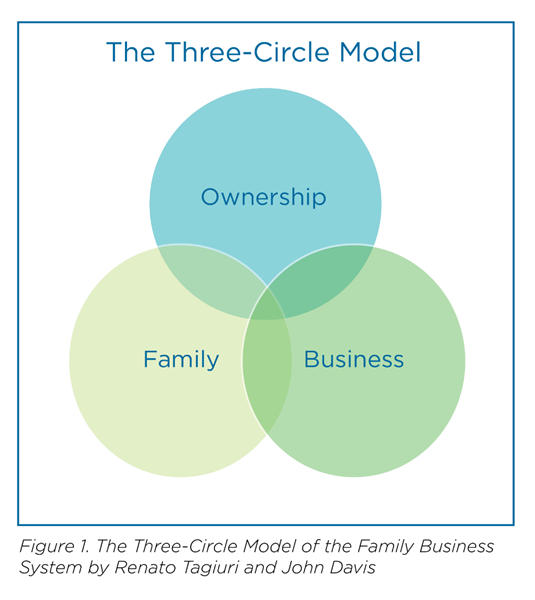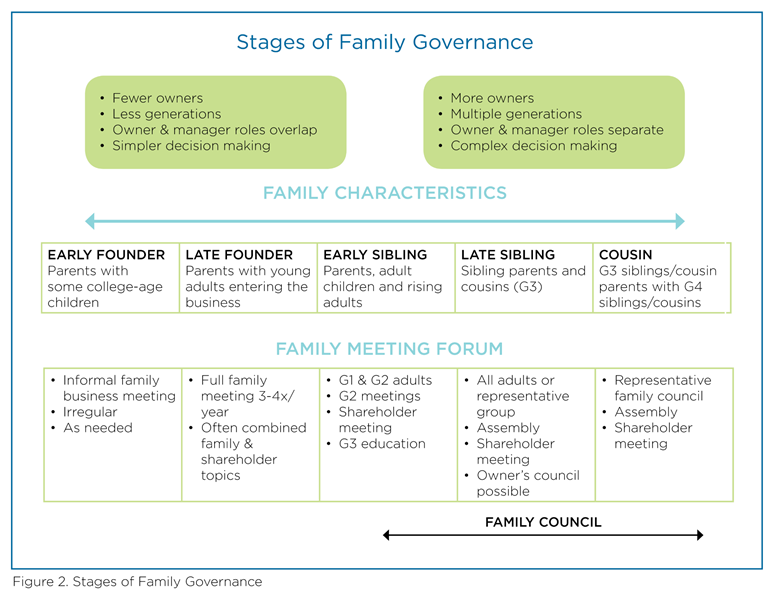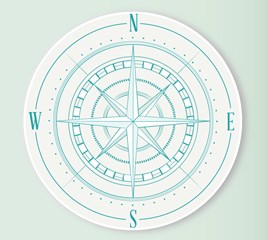For the past six years, the Walcott family has gathered for their family business meeting on the Saturday after the founder Grandpa George’s birthday. The 12 attendees range in age from 62 to 11 and include George, his three children and their families.
The agenda has evolved over the past decade. Generally, the annual meeting begins with George reflecting on the past year and sharing a story about the growth of the fish farming business since its humble beginnings in 1970. Then he and his son Bill, who joined in 2005, report how the business performed over the last 12 months and the outlook for the upcoming year. The farm’s lawyer provides a quick review of the ownership structure. Next, an industry expert or a family business consultant conducts a 30-minute educational session. Sometimes, the family discusses and decides on a charity or service project to support. The meeting usually wraps up in less than four hours.
The Walcotts are employing an approach to address questions many families wonder about. How do we educate our family members so that they can be effective owners and contributors to the family legacy? How can family members’ voices be heard if they see issues within the business? Who can work in the family business?
What is Family Governance?
The Three-Circle Model of the Family Business System (Figure 1) was developed at Harvard Business School in 1982 and continues to be the central organizing framework for understanding family business systems. The diagram represents three interdependent and overlapping systems in a family enterprise: family, ownership and business. For a family business to function effectively over time, each system must understand how to interact with and support the other systems. In addition, people within each system should appreciate which decisions are theirs to make. This interaction, support and decision making is governance. Family governance is a process or structure to educate and facilitate communication between family members. It also provides a forum for constructive discussion, problem solving and decisions about the family as it relates to the business, as well as, how the business relates to the family.

In the case of the Walcotts, each system has its own governance strategy. For the ownership circle, George and Bill (who are senior managers and own the voting shares) use a board with advisors who are unconnected to the fish farm to help them make decisions on behalf of the shareholders. The business circle is governed by the farm’s senior management team. The annual Walcott family meetings have created a space for the family system to have a voice.
The Role of Family Governance
Any family governance structure builds a strong family by providing a forum to:
- Set the vision for the family and define its philosophy towards the family’s relationship with the business and the businesses’ support of the family.
- Uncover and maintain the values by which the family and related enterprises will operate.
- Educate family about rights and responsibilities of ownership, family history and values, and prepare for the future.
- Establish and maintain an effective plan for ownership and key family leadership role succession.
- Celebrate individual and family milestones.
- Stay informed and communicate with owners.
- Recognize and resolve family conflict to promote harmony.
How a family tackles these tasks is contingent on how complex and how aligned the business, ownership and family systems are. The “right” family governance structure depends on the following factors:
- How many owners are there?
- How many generations are in the family? How many are involved in the business?
- Are owners serving in management roles? How many generations are in management roles? Are there non-family executives in place?
- How large is the business? What resources are available to family members?
- Do family members know each other? Are they in agreement about the business? Is there potential for disagreement?
- Who will be involved in family decision-making? How will decisions be made?
The Stages of Family Governance
Families like the Walcotts often find that the way they make decisions together evolves with the size and configuration of the family. In the early years of the business and the family, communication and decision-making are more casual, often taking place around the kitchen table. As children move out of the founder’s house to start their lives as young adults, it becomes increasingly important to be intentional about communication methods and decision-making processes. As the family and the business grow, the need for more formal governance also evolves.
However, just because your family doesn’t have more than two generations, doesn’t mean you shouldn’t think about how you can institute effective family governance. The good news is that if your family business systems are straightforward, how you accomplish family governance can be pretty simple, too. For many, family governance starts with well-planned family meetings.
The Stages of Family Governance diagram (Figure 2) outlines different family governance approaches based on the complexity and interaction of the family and the business.

The Walcotts found themselves between the second and third boxes from the left in the bottom row of Figure 2. George and Bill started holding family meetings when George’s son-in-law, Fred, began asking questions about the value of his wife’s nonvoting shares and seemed to be second-guessing the fish farm’s strategic plan. After three years of post-birthday family meetings, they decided to also schedule adult-only meetings two additional times each year to create more alignment between the family and the business. With five third-generation members interested in summer jobs and George thinking about retirement, there were many important topics to discuss. George and his children decided to include spouses in the meetings so that they could hear things firsthand and actively participate.
Managing Effective Family Meetings
Knowing that making decisions together would require a different type of interaction, the Walcott adults spent their first meeting learning more about each other. They explored each other’s strengths, interests, skills and communication and learning styles. In their second meeting, they identified shared family values and a vision for the future of the family. These meetings created a deeper appreciation of each other, a framework for future decisions and a sense of purpose.
The family agreed to focus on addressing two key questions:
- How can we assure that we are being responsible and committed to the stewardship of the family’s assets?
- What can we do to assure that we have effective, healthy and strong family relationships?
In their subsequent meetings, the Walcotts started developing family business policies. They began with straightforward policies like next generation family employment, a code of conduct policy for interacting with each other as well as those in the business, and a family decision-making process. As they started to dive into more complex topics, the meetings began to meander and frustration was building.
They decided to bring in a family business consultant to plan and facilitate the meetings so they could explore how other families create policies. The Walcotts wanted to make sure everyone in the family had an equal voice in discussions. It became obvious that it was much easier to figure out what to make for Thanksgiving dinner than it was to plan for the future of the family and the business. Fred had to learn how to listen thoughtfully and George’s brother had to work on sharing his concerns without getting angry.
Embrace the Process and Results
When a business-owning family proactively anticipates challenges, there is a greater chance of creating and maintaining alignment between the family and the business. During the first two years of additional family meetings, the Walcott adults had some real wins. They also bumped up against roadblocks that helped them understand the importance of continuing to meet regularly.
Examples of their accomplishments and upcoming challenges include:
| Accomplishments | Challenges Ahead |
|---|---|
| Family actively listening, focusing on win-wins and building trusting relationships | Quieter members still holding back; difficulty balancing fast-paced styles with those who need to think longer |
| Adopted family decision-making process to be able to speak with one voice on policies towards the business | A spouse chatting with her friend (who is the CFO) about confidential family meeting discussions |
| G2 family members developed assurance that their interests were being considered by G1, and gained confidence in management | Bob and George made a few unilateral decisions without connecting with the family; they needed to be reminded of the family process and role |
| Defined the roles and responsibilities of shareholders, board and management | Need to develop buy-sell agreement so that shareholders have a way to exit, if desired |
| Developed a board member job description and key attributes desired in independent directors | Determine how a family member might qualify for a board position and the nomination process |
| Identified education topics around the business, family dynamics and financial essentials for G1/G2 | When and how to begin to educate G3 about the business |
The Walcott’s family governance process evolved naturally. Fred’s questions prompted Bob and George to consider being more transparent with everyone. The benefit of creating a shared understanding and appreciation for the business, learning about the family’s heritage, understanding what it means to become effective owners, and looking towards developing the next generation was exciting for everyone. After two years, they were comfortable with committing the time and resources to support their investment in the business, and they truly appreciated the deep connections created within the family.
Building an effective family governance forum is an evolving process. By definition, family governance entails embracing a broad range of perspectives, multiple generations and people who have other things going on in their lives. It can be difficult to maintain the momentum. Family members who work in the business and are used to more direct and efficient process can find family governance frustrating. The process of building a family business governance system requires patience, perseverance in the short-term. Most families find the long-term result of a stronger family and aligned systems, like the Walcotts are experiencing, produces a rewarding outcome for both the family and the business.

